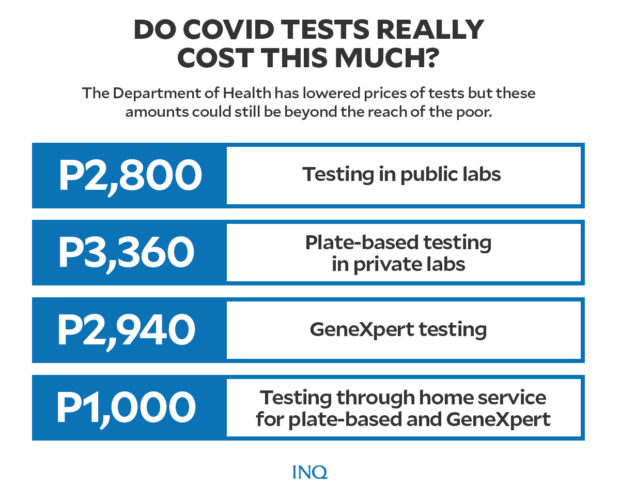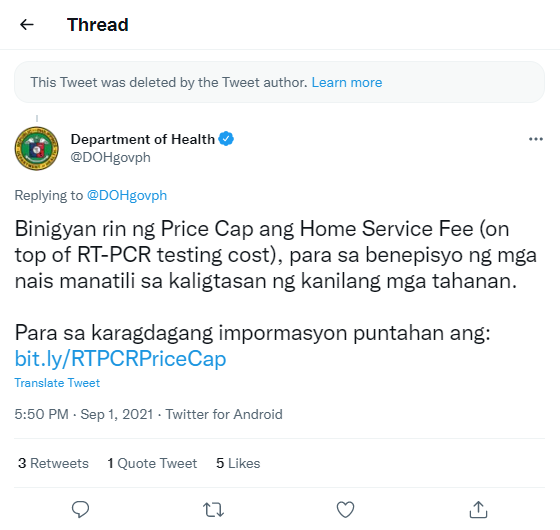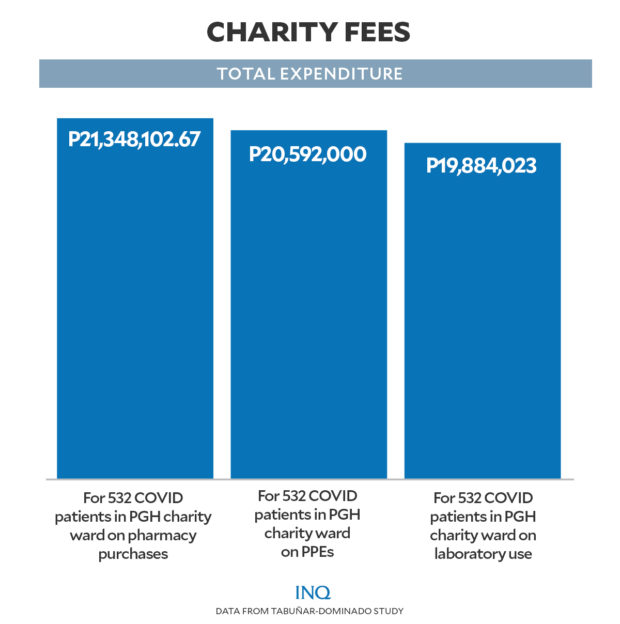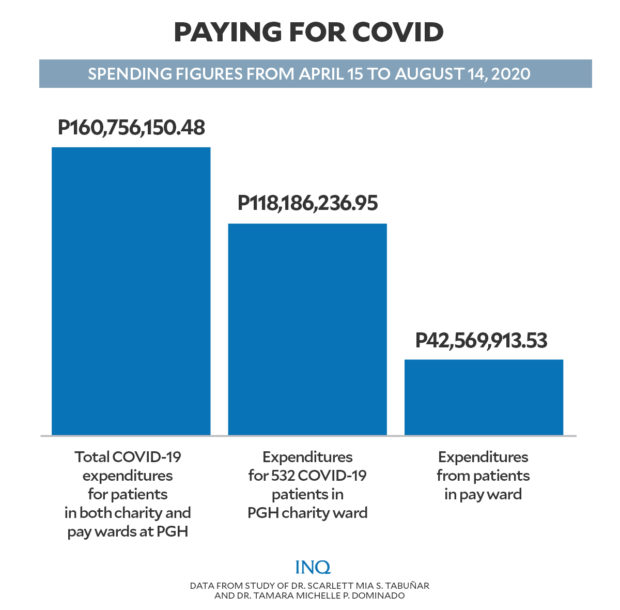Surviving COVID-19: A costly struggle

Patients cram a hospital in Quezon City as a surge in COVID-cases puts health facilities to severe tests. REUTERS
MANILA, Philippines—As the country’s total COVID-19 cases continue to rise with over 10,000 new daily infections, more patients are being sent to the hospital.
As of Thursday (Sept. 2), the Philippines recorded 16,621 new COVID-19 cases, bringing the total confirmed COVID-19 cases to 2,020,484.
Of these, 146,510 are active cases while 1,840,294 recovered and 33,680 died of the disease.
READ: 16,621 new COVID-19 cases in PH push active count to 146,510
Admission and treatment of COVID patients can cost a lot, especially in private hospitals. Below are some of the hospital bills and other costs incurred by COVID-19 patients in the country.
RT-PCR Test
The Department of Health (DOH)has recently announced the adjusted price cap for Reverse Transcription Polymerase Chain Reaction (RT-PCR) tests in the country.
According to DOH, it has made the COVID-19 test more affordable to the public amid rising cases of COVID-19, as well as the emerging threat of the highly transmissible Delta variant.
Based on DOH Circular No. 2021-0374 dated August 26, the price cap for RT-PCR tests starting Sept. 6 will be:
- Public laboratories: P2,800 for plate-based and P2,450 for GeneXpert
- Private laboratories: P3,360 for plate-based and P2,940 for GeneXpert
- Home service: P1,000 for plate-based and GeneXpert
READ: DOH lowers price cap for RT-PCR testing
However, the health department has since deleted its Twitter post which included the infographics on the new price cap.
Hospital bills
A study conducted by Dr. Scarlett Mia S. Tabuñar and Dr. Tamara Michelle P. Dominado, of the Department of Energy Medicine at the University of the Philippines-Philippine General Hospital (UP-PGH), gave an overview of the hospitalization expenses of COVID-19 patients in PGH.
The study—which was published last April in Acta Medica Philippina, a peer-reviewed general medical and health science journal published by the UP Manila—focused on the overall expenses, out-of-pocket (OOP) charges, cost centers utilization, and other hospitalization expenditure sources incurred by patients during the first few months of the pandemic in 2020.
The data on the breakdown of hospital bills were divided into two categories: the expenditure of patients admitted in charity wards and those who were admitted in the pay ward.
The overall total expenditure for 691 COVID-19 patients admitted in both wards from April 15 to Aug. 14 last year was P160,756,150.48, or $3,342,483.00.
A huge portion, around 74 percent, was spent on charity ward admissions with P118,186,236.95 or $2,457,358.75 for 532 patients.
Private COVID-19 patients in the pay ward accounted for 26 percent of all patients with an expenditure of P42,569,913.53 or $888,255,38 in the same period.
The researchers found that the top three expenses for charity ward patients were pharmacy supplies, PPE and laboratory use.
- Pharmacy: 18.06 percent of expenses with an average P40,128.01 expense per patient or total expenses worth P21,348,102.67 for 532 patients of the charity ward.
- PPE usage: 17.42 percent of expenses with P38,706.77 average cost per patient or total expenses worth P20,592,000.00 for 532 patients of the charity ward.
- Laboratory: 16.82 percent of expenses, with a P37,375.98 average cost per patient or total expenses worth P19,884,023.00 for 532 patients of the charity ward.
The top three cost factors were similar for pay patients.
- Laboratory: 19.02 percent of expenses with a P51,606.75 average cost per patient or total expenses worth P8,098,765.00 for 159 patients of the pay ward.
- Pharmacy: 15.01 percent of expenses with a P40,174.46 average cost per patient or total expenses worth P6,387,738.83 for 159 patients of the pay ward.
- PPE usage: 12.99 percent of expenses with a P34,988.16 average cost per patient or total expenses worth P5,528,129.00 for 159 patients of the pay ward.
An examination of the data would show doctor’s professional fees having the biggest slice of the expense pie for both charity and pay ward patients.
- Charity ward: 37.81 percent of expenses on doctor’s fees with a P83,996.07 average cost per patient or total expenses worth P44,685,909.00 for 532 patients of the charity ward.
- Private or pay ward: 35.66 percent of expenses with a P94,868.77 average cost per patient or total expenses worth P15,179,003.20 for 159 patients of the pay ward.
“It is however noted that doctor’s fee and room rate were fixed for charity beneficiaries based on severity of COVID infection and were not charged to patients,” the researchers said.
According to them, lab, pharmacy, and PPE expenses of health care workers make up the biggest share of overall spending for both charity and private ward patients—51 percent. Labs eat up most of the expense at P27,982,788. Pharmaceuticals followed at P27,735,841.50 and PPEs at P26,120,129.
Majority of patients who settled their hospital bills out-of-pocket were below 60 years old with payments ranging from P25,899 to P44,428.63.
Out-of-pocket paying patients above 60 years old shelled out a range of P4,050.60 to P39,920.20.
The study, however, said patients older than 60 and PGH employees are qualified for 20 percent and between 30 and 50 percent discounts through PhilHealth coverage. This, the researchers said, “could explain the resulting lower out of pocket payments for senior citizens.”
The most out-of-pocket payment came from 51 patients under the 19-30 age group with Php 44,428.63 each.
On the other hand, the least out-of-pocket payment was from four patients older than 91 years old at only P4,005.60, “which can also be due to it having the least number of patients afflicted with COVID-19.”
The study also showed the increase in the monthly average expenditure of COVID-19 patients from April 2020 (1 percent) to August 2020 (18 percent).
According to the researchers, this was expected due to the increasing number of patients with more severe COVID-19, which coincided with the peak of pandemic cases in 2020.
“The uncertainty of projecting the cost of COVID-19 care is a major challenge most strikingly seen at the start of the COVID-19 pandemic,” Tabuñar and Dominado wrote in their study.
“The overall health and financial burden of cases result from the overcapacity of hospitals admitting those needing medical care,” they added.
A report published last year by INQUIRER.NET told the story of Jorge “Jojy” Azurin, a 56-year-old health technology entrepreneur and father of five, who was hospitalized last year due to COVID-19.
According to Azurin, his total hospital bill from late March to early April 2020 was “between P1.2 million and P1.5 million.”
On average, his confinement had cost P70,000 to P80,000 per day in a hospital in Pasig City.
According to his computation, the rough breakdown of his COVID-19 expenses looked like this:
- 30 percent for his medicines
- 25 percent for his accommodation—including eight days in the emergency room, five days at the intensive care unit (ICU), and five days in a private room
- 15 percent was for nursing services and medical supplies
- 10 percent for professional fees of medical staffers and other expenses
READ: Survivor’s fight vs COVID-19 took 18 days, cost over P1M
In a phone interview last April 26, a nephew of another COVID-19 patient in Oriental Mindoro told INQUIRER.NET that the family once had a running bill which amounted to P2 million.
Meanwhile, according to former government health adviser Dr. Tony Leachon, COVID-related hospital bills could reach up to P3 million depending on the severity of the case.
“It depends on the severity of the Covid – mild , moderate or severe. Range = 1 million to 3 million,” Leachon told INQUIRER.NET.
It should be noted that hospital costs for COVID-19 can differ depending on the hospital—public or private—and the region or area where the patient is admitted.
PhilHealth coverage
For some, Philippine Health Insurance Corporation’s (PhilHealth) benefit packages provide a huge relief as it aims to cover medical expenses for Filipinos diagnosed with the disease.
According to PhilHealth Circular No. 2020-0009 dated April 8, 2020, the agency offered benefit packages for probable and confirmed cases depending on the severity of the cases.
https://www.philhealth.gov.ph/circulars/2020/circ2020-0009.pdf
“Under the Universal Health Care Act (RA 11223), PhilHealth shall ensure equitable access to quality, affordable, and accessible health care services by all Filipinos,” the circular read.
“By providing coverage for inpatient care of probable and confirmed COVID-19 developing severe illness or outcomes, PhilHealth…shall cover the comprehensive case management for COVID-19,” the circular read.
PhilHealth offers these benefits for inpatient case management for probable or confirmed COVID-19 patients:
- P43,997 for mild pneumonia among elderly and with comorbidity in Level 1 to Level 3 hospitals and in private rooms
- P143,267 for mild pneumonia in Level 1 to Level 4 hospitals in private rooms
- P335,519 for severe pneumonia in Level 2 to Level 3 hospitals in private rooms and intensive care unit
- P786,384 for critical pneumonia in Level 2 to Level 3 hospitals in private rooms and ICU
A separate circular issued by PhilHealth in June this year said only COVID cases confirmed by RT-PCR tests with severe symptoms requiring hospital stay would be eligible to claim benefits under the four packages.
The state health insurer also offered an intermediate package for cases with pneumonia which were initially assessed and managed as COVID-19 but had negative RT-PCR test results.
The package covers the following rates:
- P18,000 for moderate pneumonia
- P38,000 for severe or critical pneumonia
The package included payment for medicines, diagnostics and lab use, room and board and supplies and equipment including PPEs and professional fees, PhilHealth said.
https://www.philhealth.gov.ph/circulars/2021/circ2021-0008.pdf
Health Undersecretary Leopoldo Vega also in July said PhilHealth planned to roll out benefit packages for COVID patients with mild and moderate symptoms and in isolation at home or other care facilities.
READ: PhilHealth to unveil benefit packages for mild, moderate COVID-19 patients on home isolation
TSB
RELATED STORY: COVID cases sending NCR hospitals to ICU
For more news about the novel coronavirus click here.
What you need to know about Coronavirus.
For more information on COVID-19, call the DOH Hotline: (02) 86517800 local 1149/1150.
The Inquirer Foundation supports our healthcare frontliners and is still accepting cash donations to be deposited at Banco de Oro (BDO) current account #007960018860 or donate through PayMaya using this link.



